A Study of Salt Tolerance: Wild vs. Cultivated Rice Varieties
VerifiedAdded on 2021/01/11
|18
|4314
|392
Project
AI Summary
This project investigates the physiological aspects of salt tolerance in wild and cultivated rice varieties. It employs primary data collection methods, primarily questionnaires, to gather information from respondents regarding their awareness and understanding of rice cultivation, the differences between cultivated and wild rice, and the challenges posed by salinity. The study explores the importance of rice as a staple food in Southeast Asia and examines the major problems affecting rice production, such as rising sea levels and salt salinity. The results, presented through interpretations of the survey responses, indicate that while cultivated rice is more commonly known, wild rice exhibits greater potential for salt tolerance. The research highlights the ethical considerations involved in data collection, including informed consent and confidentiality, and acknowledges limitations such as time and financial constraints. The findings suggest that wild rice may offer a sustainable solution to rice cultivation in saline environments, providing valuable insights for future agricultural practices and research.
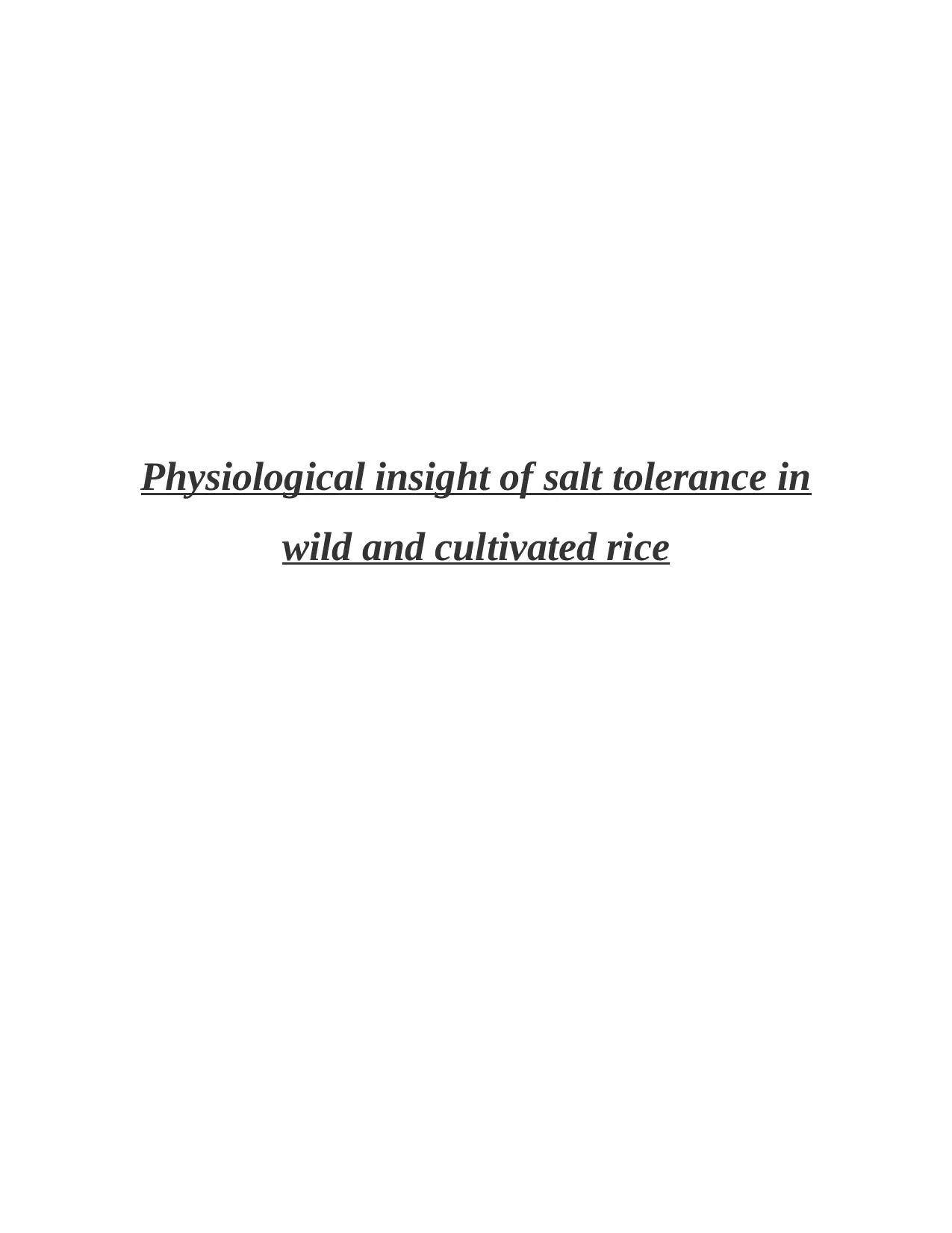
Physiological insight of salt tolerance in
wild and cultivated rice
wild and cultivated rice
Paraphrase This Document
Need a fresh take? Get an instant paraphrase of this document with our AI Paraphraser
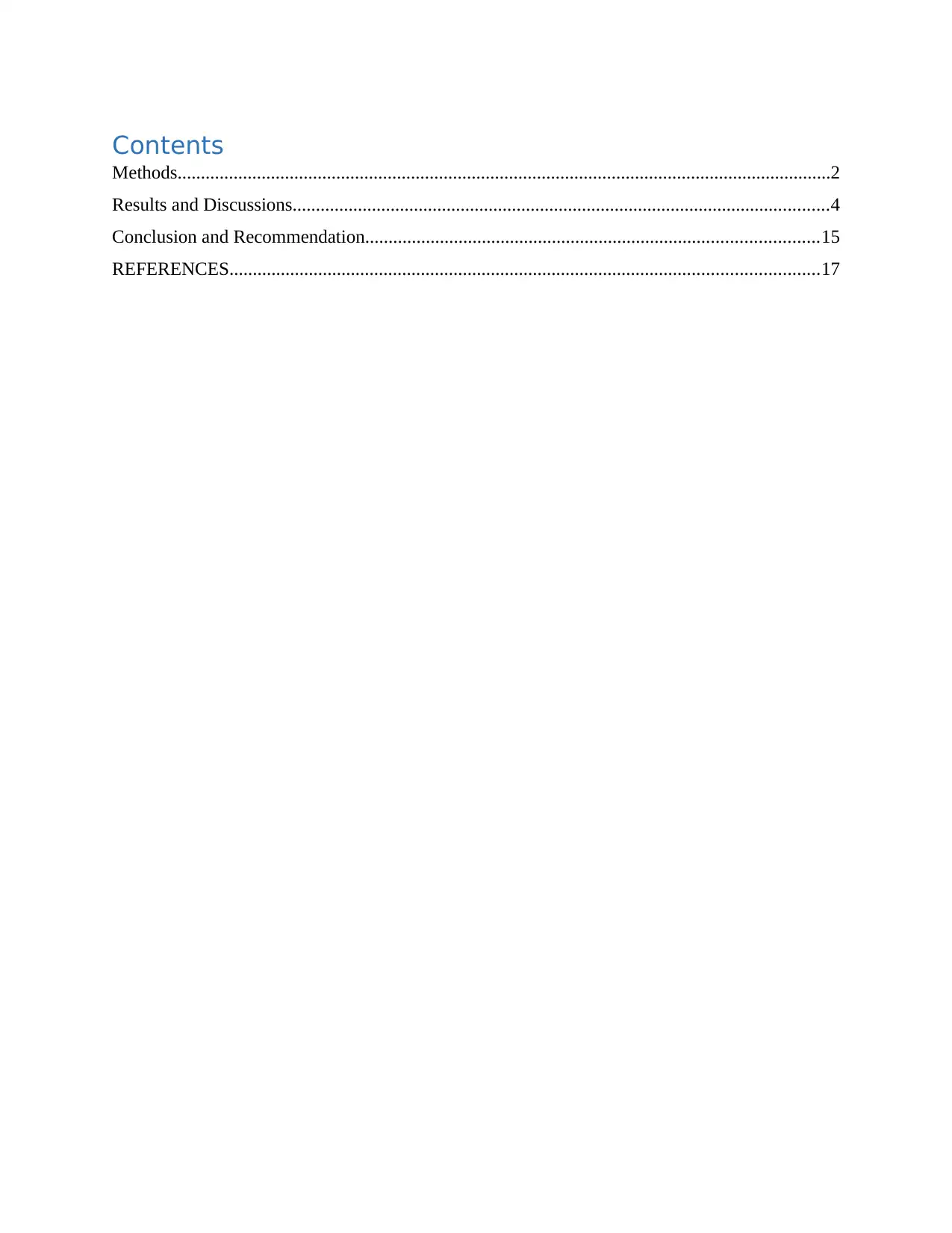
Contents
Methods............................................................................................................................................2
Results and Discussions...................................................................................................................4
Conclusion and Recommendation.................................................................................................15
REFERENCES..............................................................................................................................17
Methods............................................................................................................................................2
Results and Discussions...................................................................................................................4
Conclusion and Recommendation.................................................................................................15
REFERENCES..............................................................................................................................17
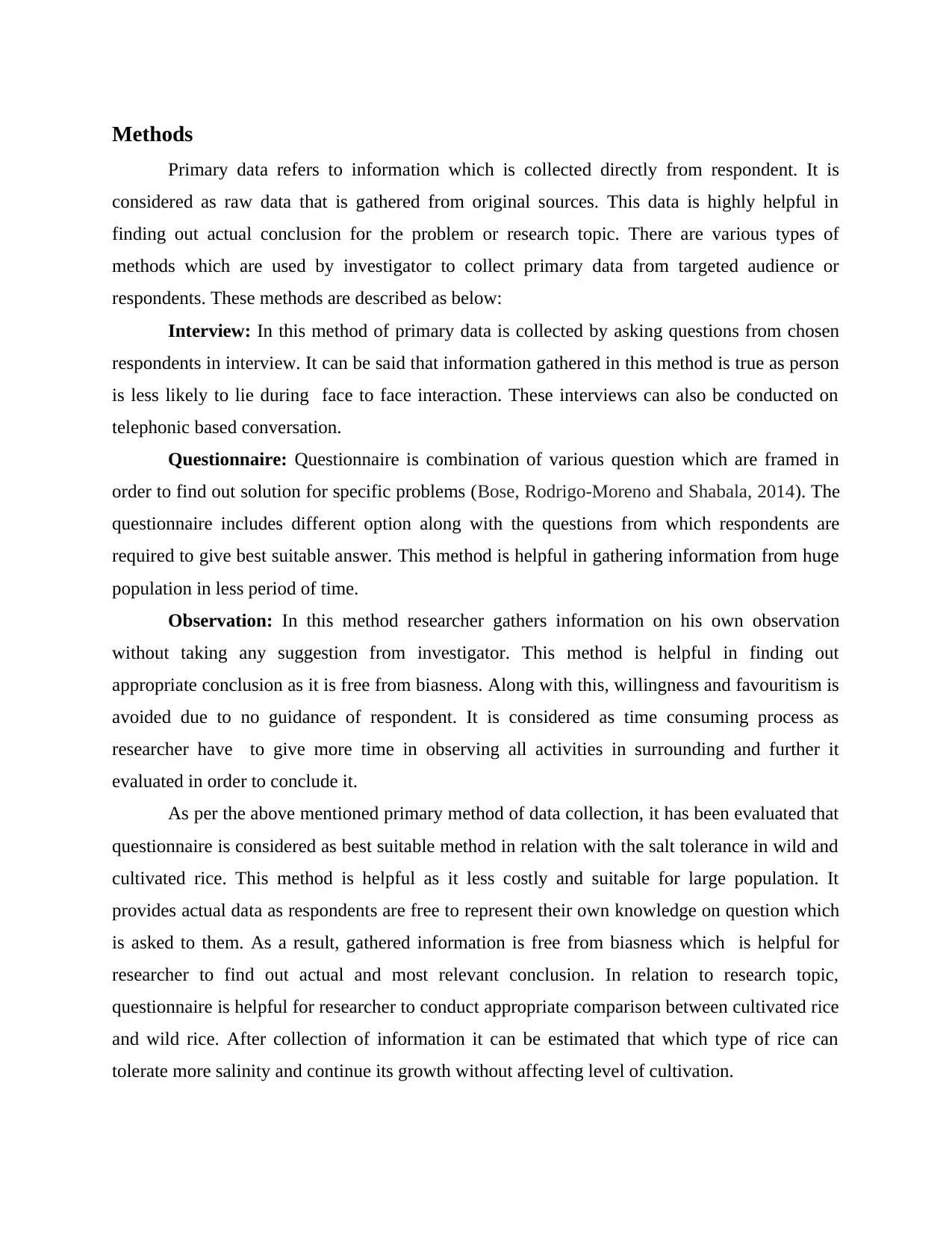
Methods
Primary data refers to information which is collected directly from respondent. It is
considered as raw data that is gathered from original sources. This data is highly helpful in
finding out actual conclusion for the problem or research topic. There are various types of
methods which are used by investigator to collect primary data from targeted audience or
respondents. These methods are described as below:
Interview: In this method of primary data is collected by asking questions from chosen
respondents in interview. It can be said that information gathered in this method is true as person
is less likely to lie during face to face interaction. These interviews can also be conducted on
telephonic based conversation.
Questionnaire: Questionnaire is combination of various question which are framed in
order to find out solution for specific problems (Bose, Rodrigo-Moreno and Shabala, 2014). The
questionnaire includes different option along with the questions from which respondents are
required to give best suitable answer. This method is helpful in gathering information from huge
population in less period of time.
Observation: In this method researcher gathers information on his own observation
without taking any suggestion from investigator. This method is helpful in finding out
appropriate conclusion as it is free from biasness. Along with this, willingness and favouritism is
avoided due to no guidance of respondent. It is considered as time consuming process as
researcher have to give more time in observing all activities in surrounding and further it
evaluated in order to conclude it.
As per the above mentioned primary method of data collection, it has been evaluated that
questionnaire is considered as best suitable method in relation with the salt tolerance in wild and
cultivated rice. This method is helpful as it less costly and suitable for large population. It
provides actual data as respondents are free to represent their own knowledge on question which
is asked to them. As a result, gathered information is free from biasness which is helpful for
researcher to find out actual and most relevant conclusion. In relation to research topic,
questionnaire is helpful for researcher to conduct appropriate comparison between cultivated rice
and wild rice. After collection of information it can be estimated that which type of rice can
tolerate more salinity and continue its growth without affecting level of cultivation.
Primary data refers to information which is collected directly from respondent. It is
considered as raw data that is gathered from original sources. This data is highly helpful in
finding out actual conclusion for the problem or research topic. There are various types of
methods which are used by investigator to collect primary data from targeted audience or
respondents. These methods are described as below:
Interview: In this method of primary data is collected by asking questions from chosen
respondents in interview. It can be said that information gathered in this method is true as person
is less likely to lie during face to face interaction. These interviews can also be conducted on
telephonic based conversation.
Questionnaire: Questionnaire is combination of various question which are framed in
order to find out solution for specific problems (Bose, Rodrigo-Moreno and Shabala, 2014). The
questionnaire includes different option along with the questions from which respondents are
required to give best suitable answer. This method is helpful in gathering information from huge
population in less period of time.
Observation: In this method researcher gathers information on his own observation
without taking any suggestion from investigator. This method is helpful in finding out
appropriate conclusion as it is free from biasness. Along with this, willingness and favouritism is
avoided due to no guidance of respondent. It is considered as time consuming process as
researcher have to give more time in observing all activities in surrounding and further it
evaluated in order to conclude it.
As per the above mentioned primary method of data collection, it has been evaluated that
questionnaire is considered as best suitable method in relation with the salt tolerance in wild and
cultivated rice. This method is helpful as it less costly and suitable for large population. It
provides actual data as respondents are free to represent their own knowledge on question which
is asked to them. As a result, gathered information is free from biasness which is helpful for
researcher to find out actual and most relevant conclusion. In relation to research topic,
questionnaire is helpful for researcher to conduct appropriate comparison between cultivated rice
and wild rice. After collection of information it can be estimated that which type of rice can
tolerate more salinity and continue its growth without affecting level of cultivation.
⊘ This is a preview!⊘
Do you want full access?
Subscribe today to unlock all pages.

Trusted by 1+ million students worldwide
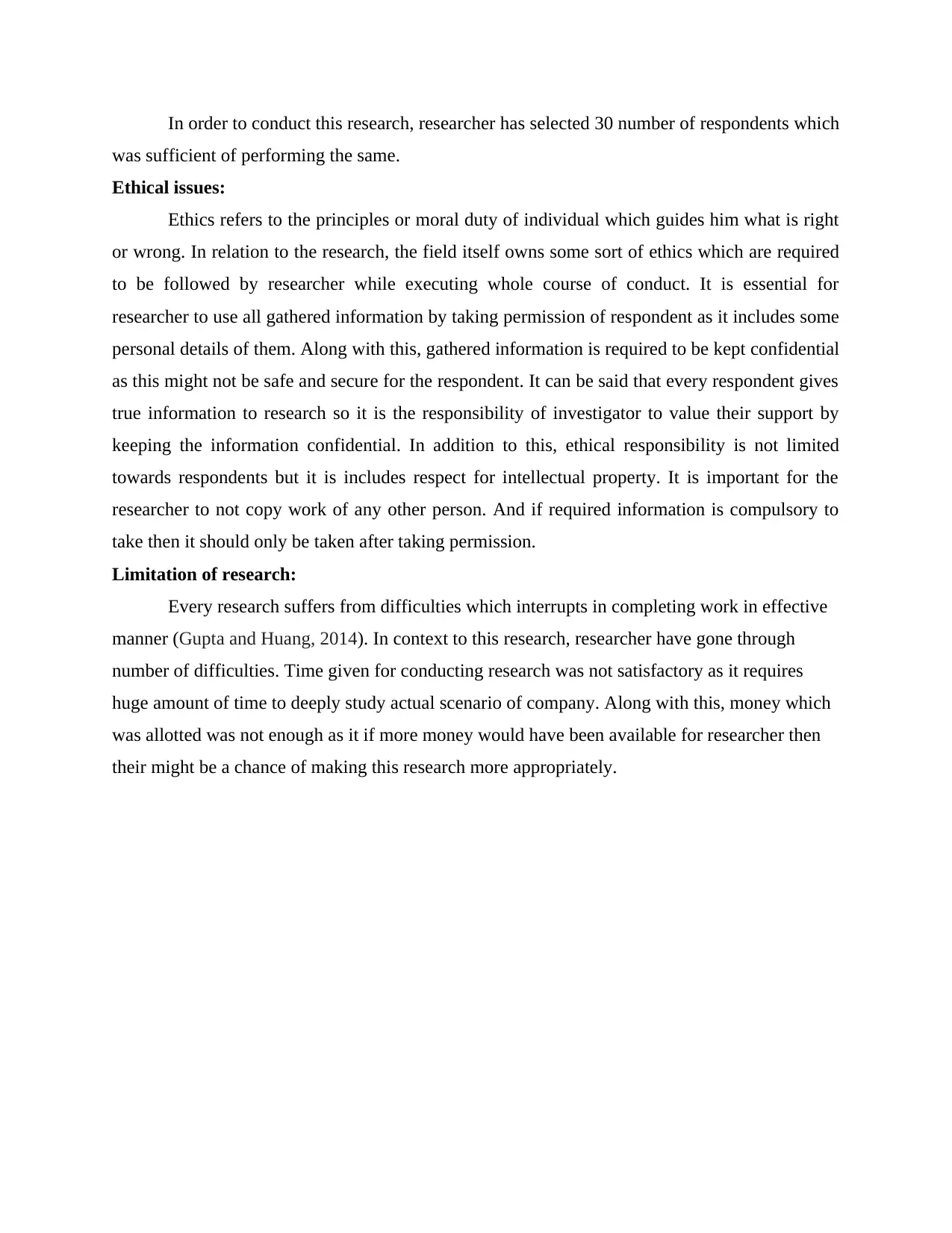
In order to conduct this research, researcher has selected 30 number of respondents which
was sufficient of performing the same.
Ethical issues:
Ethics refers to the principles or moral duty of individual which guides him what is right
or wrong. In relation to the research, the field itself owns some sort of ethics which are required
to be followed by researcher while executing whole course of conduct. It is essential for
researcher to use all gathered information by taking permission of respondent as it includes some
personal details of them. Along with this, gathered information is required to be kept confidential
as this might not be safe and secure for the respondent. It can be said that every respondent gives
true information to research so it is the responsibility of investigator to value their support by
keeping the information confidential. In addition to this, ethical responsibility is not limited
towards respondents but it is includes respect for intellectual property. It is important for the
researcher to not copy work of any other person. And if required information is compulsory to
take then it should only be taken after taking permission.
Limitation of research:
Every research suffers from difficulties which interrupts in completing work in effective
manner (Gupta and Huang, 2014). In context to this research, researcher have gone through
number of difficulties. Time given for conducting research was not satisfactory as it requires
huge amount of time to deeply study actual scenario of company. Along with this, money which
was allotted was not enough as it if more money would have been available for researcher then
their might be a chance of making this research more appropriately.
was sufficient of performing the same.
Ethical issues:
Ethics refers to the principles or moral duty of individual which guides him what is right
or wrong. In relation to the research, the field itself owns some sort of ethics which are required
to be followed by researcher while executing whole course of conduct. It is essential for
researcher to use all gathered information by taking permission of respondent as it includes some
personal details of them. Along with this, gathered information is required to be kept confidential
as this might not be safe and secure for the respondent. It can be said that every respondent gives
true information to research so it is the responsibility of investigator to value their support by
keeping the information confidential. In addition to this, ethical responsibility is not limited
towards respondents but it is includes respect for intellectual property. It is important for the
researcher to not copy work of any other person. And if required information is compulsory to
take then it should only be taken after taking permission.
Limitation of research:
Every research suffers from difficulties which interrupts in completing work in effective
manner (Gupta and Huang, 2014). In context to this research, researcher have gone through
number of difficulties. Time given for conducting research was not satisfactory as it requires
huge amount of time to deeply study actual scenario of company. Along with this, money which
was allotted was not enough as it if more money would have been available for researcher then
their might be a chance of making this research more appropriately.
Paraphrase This Document
Need a fresh take? Get an instant paraphrase of this document with our AI Paraphraser
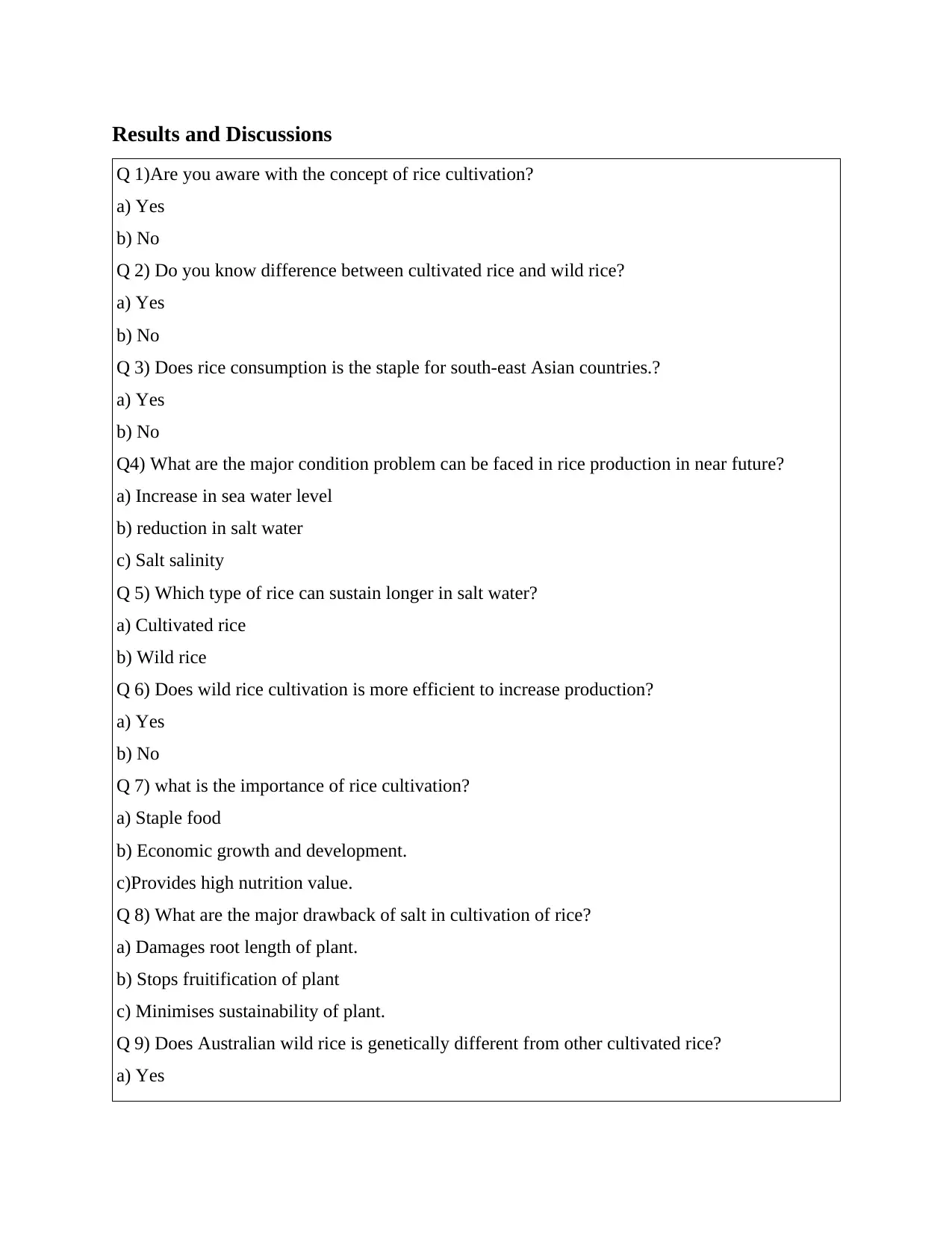
Results and Discussions
Q 1)Are you aware with the concept of rice cultivation?
a) Yes
b) No
Q 2) Do you know difference between cultivated rice and wild rice?
a) Yes
b) No
Q 3) Does rice consumption is the staple for south-east Asian countries.?
a) Yes
b) No
Q4) What are the major condition problem can be faced in rice production in near future?
a) Increase in sea water level
b) reduction in salt water
c) Salt salinity
Q 5) Which type of rice can sustain longer in salt water?
a) Cultivated rice
b) Wild rice
Q 6) Does wild rice cultivation is more efficient to increase production?
a) Yes
b) No
Q 7) what is the importance of rice cultivation?
a) Staple food
b) Economic growth and development.
c)Provides high nutrition value.
Q 8) What are the major drawback of salt in cultivation of rice?
a) Damages root length of plant.
b) Stops fruitification of plant
c) Minimises sustainability of plant.
Q 9) Does Australian wild rice is genetically different from other cultivated rice?
a) Yes
Q 1)Are you aware with the concept of rice cultivation?
a) Yes
b) No
Q 2) Do you know difference between cultivated rice and wild rice?
a) Yes
b) No
Q 3) Does rice consumption is the staple for south-east Asian countries.?
a) Yes
b) No
Q4) What are the major condition problem can be faced in rice production in near future?
a) Increase in sea water level
b) reduction in salt water
c) Salt salinity
Q 5) Which type of rice can sustain longer in salt water?
a) Cultivated rice
b) Wild rice
Q 6) Does wild rice cultivation is more efficient to increase production?
a) Yes
b) No
Q 7) what is the importance of rice cultivation?
a) Staple food
b) Economic growth and development.
c)Provides high nutrition value.
Q 8) What are the major drawback of salt in cultivation of rice?
a) Damages root length of plant.
b) Stops fruitification of plant
c) Minimises sustainability of plant.
Q 9) Does Australian wild rice is genetically different from other cultivated rice?
a) Yes

b) No
⊘ This is a preview!⊘
Do you want full access?
Subscribe today to unlock all pages.

Trusted by 1+ million students worldwide

Q1 Are you aware with the concept of rice cultivation ?
Yes 11
No 19
Interpretation: As from this above graph, it has been shown that out of 30 people 11 people are
familiar with the concept of rice cultivation and 11 shows the minority of people. In Australia
less number of people are engaged with the activities related to agriculture and the rice
cultivation is the another specific activity which is a part of a particular agriculture style and
there are different types of rice that grows in the domestic and forest region of Australia and
there cultivation process are also different and only 11 people knows the original concept of rice
cultivation as they are doing this process form one generation to another generation. While there
is majority of people that are 19 who does not feel even familiar from the concept because there
working activities and work are not related to the farming activities and due to which they are
not known of the concept of rice cultivation. The one who even belong from the agriculture
activities might be they are not known of this specific cultivation process of rice or they could be
of the cultivation process of wheat or other cereal.
yes No
0
2
4
6
8
10
12
14
16
18
20
Yes 11
No 19
Interpretation: As from this above graph, it has been shown that out of 30 people 11 people are
familiar with the concept of rice cultivation and 11 shows the minority of people. In Australia
less number of people are engaged with the activities related to agriculture and the rice
cultivation is the another specific activity which is a part of a particular agriculture style and
there are different types of rice that grows in the domestic and forest region of Australia and
there cultivation process are also different and only 11 people knows the original concept of rice
cultivation as they are doing this process form one generation to another generation. While there
is majority of people that are 19 who does not feel even familiar from the concept because there
working activities and work are not related to the farming activities and due to which they are
not known of the concept of rice cultivation. The one who even belong from the agriculture
activities might be they are not known of this specific cultivation process of rice or they could be
of the cultivation process of wheat or other cereal.
yes No
0
2
4
6
8
10
12
14
16
18
20
Paraphrase This Document
Need a fresh take? Get an instant paraphrase of this document with our AI Paraphraser
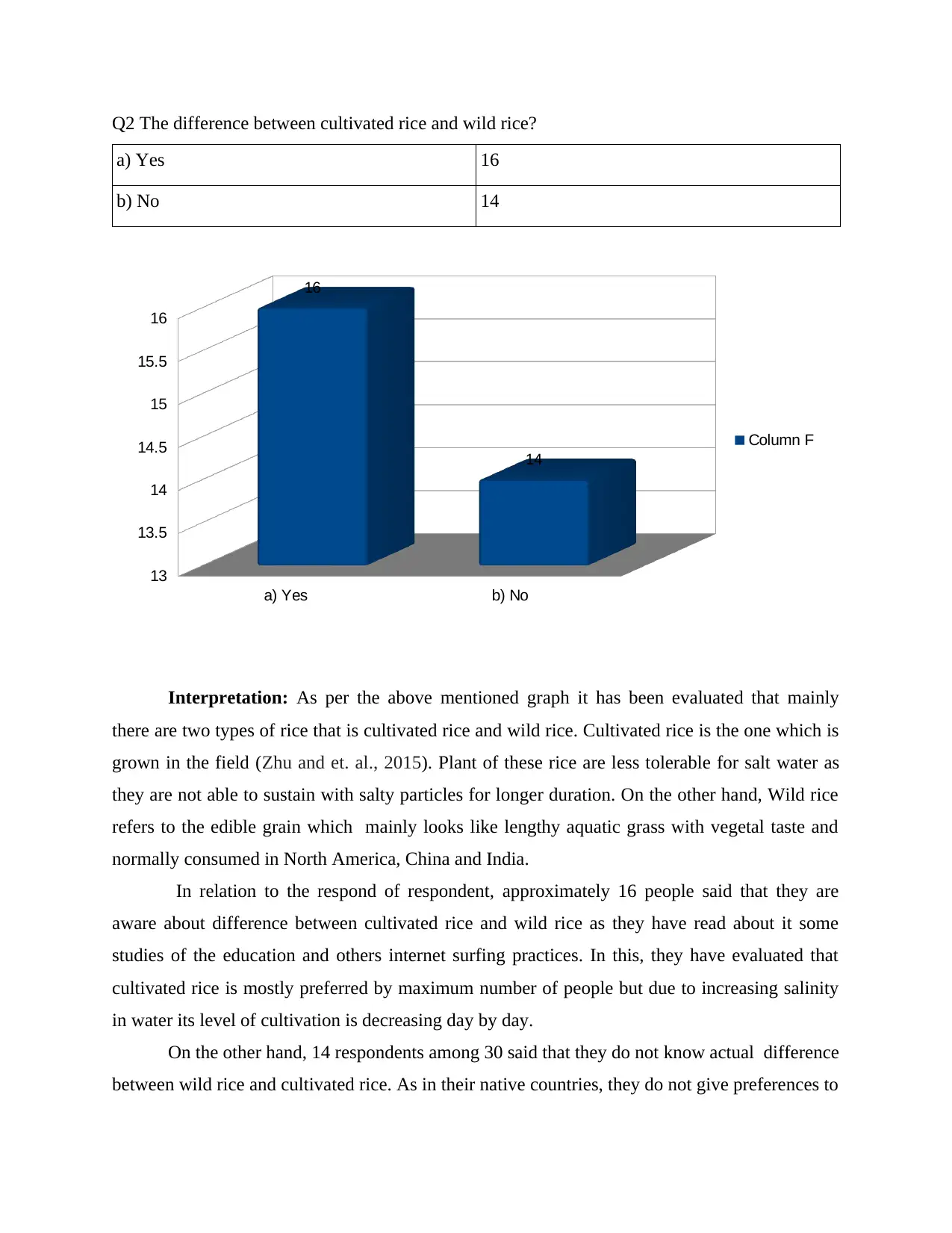
Q2 The difference between cultivated rice and wild rice?
a) Yes 16
b) No 14
Interpretation: As per the above mentioned graph it has been evaluated that mainly
there are two types of rice that is cultivated rice and wild rice. Cultivated rice is the one which is
grown in the field (Zhu and et. al., 2015). Plant of these rice are less tolerable for salt water as
they are not able to sustain with salty particles for longer duration. On the other hand, Wild rice
refers to the edible grain which mainly looks like lengthy aquatic grass with vegetal taste and
normally consumed in North America, China and India.
In relation to the respond of respondent, approximately 16 people said that they are
aware about difference between cultivated rice and wild rice as they have read about it some
studies of the education and others internet surfing practices. In this, they have evaluated that
cultivated rice is mostly preferred by maximum number of people but due to increasing salinity
in water its level of cultivation is decreasing day by day.
On the other hand, 14 respondents among 30 said that they do not know actual difference
between wild rice and cultivated rice. As in their native countries, they do not give preferences to
a) Yes b) No
13
13.5
14
14.5
15
15.5
16
16
14
Column F
a) Yes 16
b) No 14
Interpretation: As per the above mentioned graph it has been evaluated that mainly
there are two types of rice that is cultivated rice and wild rice. Cultivated rice is the one which is
grown in the field (Zhu and et. al., 2015). Plant of these rice are less tolerable for salt water as
they are not able to sustain with salty particles for longer duration. On the other hand, Wild rice
refers to the edible grain which mainly looks like lengthy aquatic grass with vegetal taste and
normally consumed in North America, China and India.
In relation to the respond of respondent, approximately 16 people said that they are
aware about difference between cultivated rice and wild rice as they have read about it some
studies of the education and others internet surfing practices. In this, they have evaluated that
cultivated rice is mostly preferred by maximum number of people but due to increasing salinity
in water its level of cultivation is decreasing day by day.
On the other hand, 14 respondents among 30 said that they do not know actual difference
between wild rice and cultivated rice. As in their native countries, they do not give preferences to
a) Yes b) No
13
13.5
14
14.5
15
15.5
16
16
14
Column F
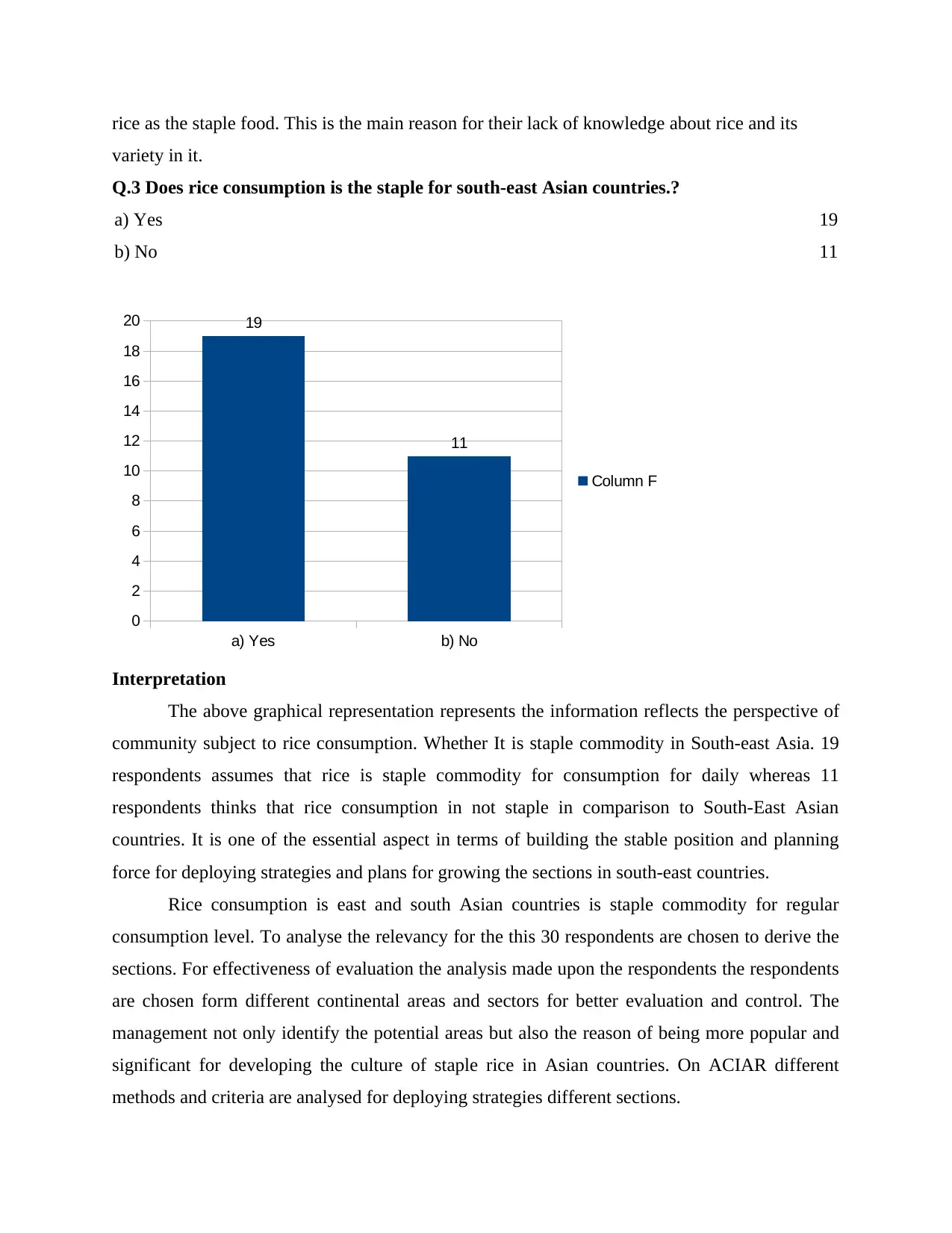
rice as the staple food. This is the main reason for their lack of knowledge about rice and its
variety in it.
Q.3 Does rice consumption is the staple for south-east Asian countries.?
a) Yes 19
b) No 11
a) Yes b) No
0
2
4
6
8
10
12
14
16
18
20 19
11
Column F
Interpretation
The above graphical representation represents the information reflects the perspective of
community subject to rice consumption. Whether It is staple commodity in South-east Asia. 19
respondents assumes that rice is staple commodity for consumption for daily whereas 11
respondents thinks that rice consumption in not staple in comparison to South-East Asian
countries. It is one of the essential aspect in terms of building the stable position and planning
force for deploying strategies and plans for growing the sections in south-east countries.
Rice consumption is east and south Asian countries is staple commodity for regular
consumption level. To analyse the relevancy for the this 30 respondents are chosen to derive the
sections. For effectiveness of evaluation the analysis made upon the respondents the respondents
are chosen form different continental areas and sectors for better evaluation and control. The
management not only identify the potential areas but also the reason of being more popular and
significant for developing the culture of staple rice in Asian countries. On ACIAR different
methods and criteria are analysed for deploying strategies different sections.
variety in it.
Q.3 Does rice consumption is the staple for south-east Asian countries.?
a) Yes 19
b) No 11
a) Yes b) No
0
2
4
6
8
10
12
14
16
18
20 19
11
Column F
Interpretation
The above graphical representation represents the information reflects the perspective of
community subject to rice consumption. Whether It is staple commodity in South-east Asia. 19
respondents assumes that rice is staple commodity for consumption for daily whereas 11
respondents thinks that rice consumption in not staple in comparison to South-East Asian
countries. It is one of the essential aspect in terms of building the stable position and planning
force for deploying strategies and plans for growing the sections in south-east countries.
Rice consumption is east and south Asian countries is staple commodity for regular
consumption level. To analyse the relevancy for the this 30 respondents are chosen to derive the
sections. For effectiveness of evaluation the analysis made upon the respondents the respondents
are chosen form different continental areas and sectors for better evaluation and control. The
management not only identify the potential areas but also the reason of being more popular and
significant for developing the culture of staple rice in Asian countries. On ACIAR different
methods and criteria are analysed for deploying strategies different sections.
⊘ This is a preview!⊘
Do you want full access?
Subscribe today to unlock all pages.

Trusted by 1+ million students worldwide
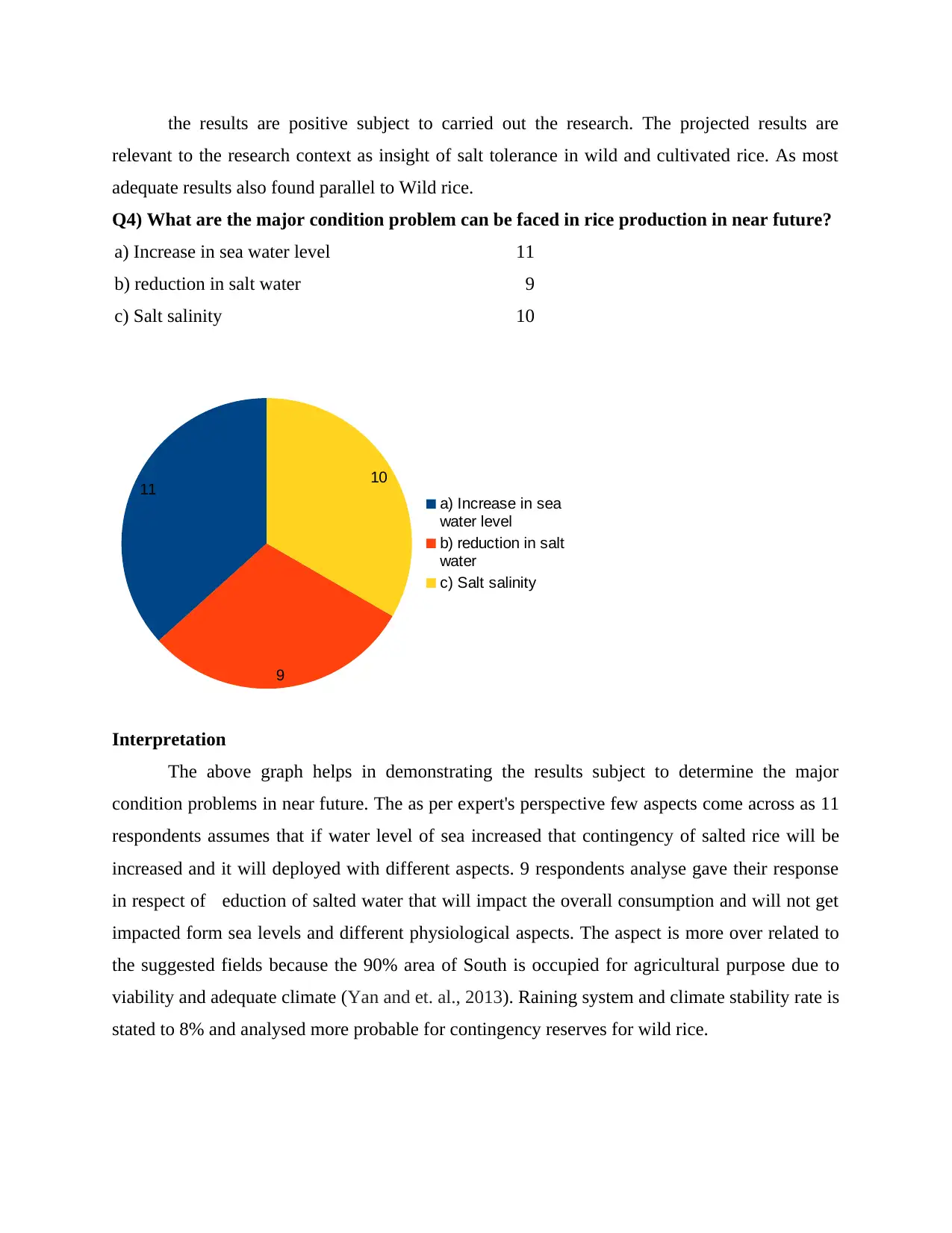
the results are positive subject to carried out the research. The projected results are
relevant to the research context as insight of salt tolerance in wild and cultivated rice. As most
adequate results also found parallel to Wild rice.
Q4) What are the major condition problem can be faced in rice production in near future?
a) Increase in sea water level 11
b) reduction in salt water 9
c) Salt salinity 10
11
9
10
a) Increase in sea
water level
b) reduction in salt
water
c) Salt salinity
Interpretation
The above graph helps in demonstrating the results subject to determine the major
condition problems in near future. The as per expert's perspective few aspects come across as 11
respondents assumes that if water level of sea increased that contingency of salted rice will be
increased and it will deployed with different aspects. 9 respondents analyse gave their response
in respect of eduction of salted water that will impact the overall consumption and will not get
impacted form sea levels and different physiological aspects. The aspect is more over related to
the suggested fields because the 90% area of South is occupied for agricultural purpose due to
viability and adequate climate (Yan and et. al., 2013). Raining system and climate stability rate is
stated to 8% and analysed more probable for contingency reserves for wild rice.
relevant to the research context as insight of salt tolerance in wild and cultivated rice. As most
adequate results also found parallel to Wild rice.
Q4) What are the major condition problem can be faced in rice production in near future?
a) Increase in sea water level 11
b) reduction in salt water 9
c) Salt salinity 10
11
9
10
a) Increase in sea
water level
b) reduction in salt
water
c) Salt salinity
Interpretation
The above graph helps in demonstrating the results subject to determine the major
condition problems in near future. The as per expert's perspective few aspects come across as 11
respondents assumes that if water level of sea increased that contingency of salted rice will be
increased and it will deployed with different aspects. 9 respondents analyse gave their response
in respect of eduction of salted water that will impact the overall consumption and will not get
impacted form sea levels and different physiological aspects. The aspect is more over related to
the suggested fields because the 90% area of South is occupied for agricultural purpose due to
viability and adequate climate (Yan and et. al., 2013). Raining system and climate stability rate is
stated to 8% and analysed more probable for contingency reserves for wild rice.
Paraphrase This Document
Need a fresh take? Get an instant paraphrase of this document with our AI Paraphraser
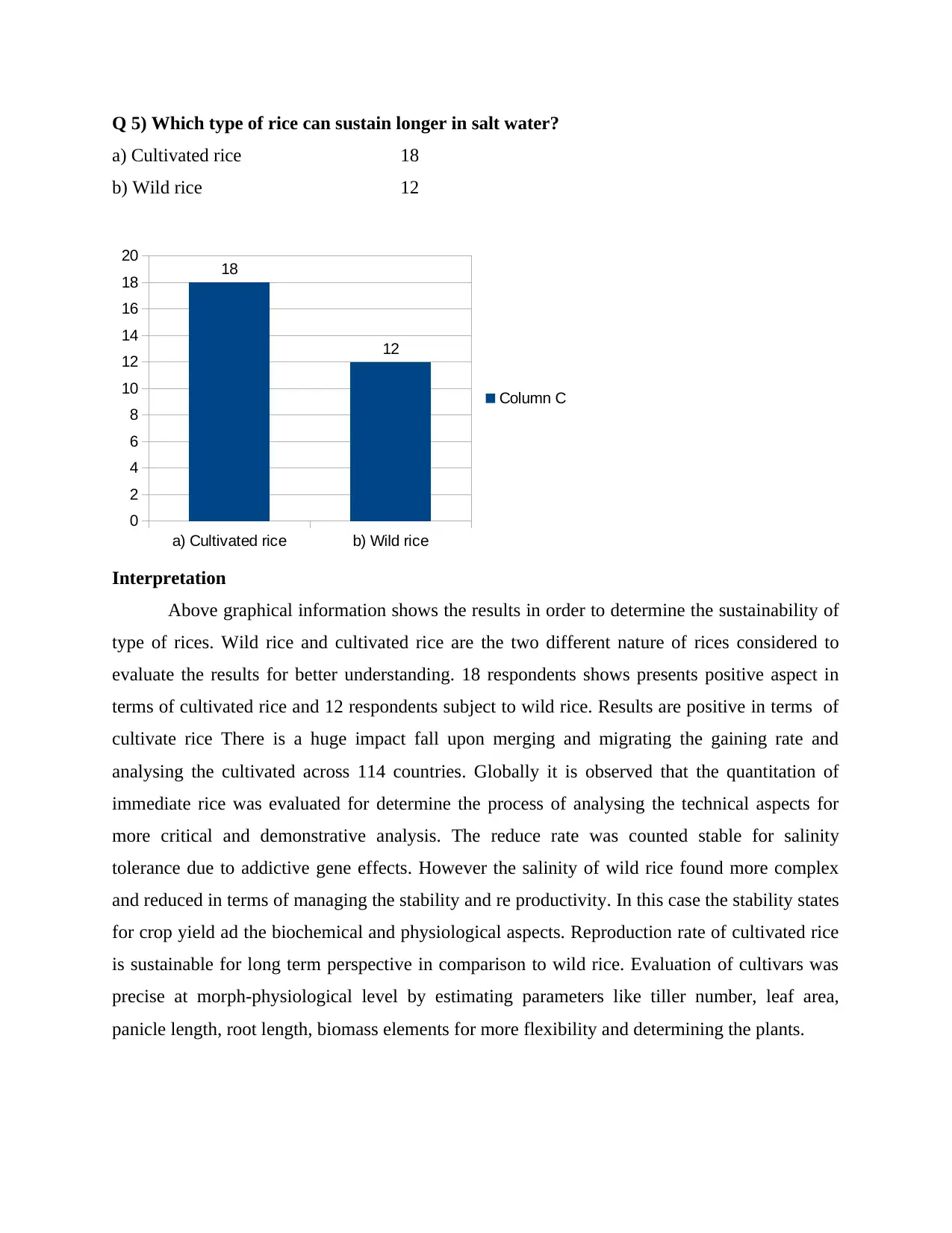
Q 5) Which type of rice can sustain longer in salt water?
a) Cultivated rice 18
b) Wild rice 12
a) Cultivated rice b) Wild rice
0
2
4
6
8
10
12
14
16
18
20 18
12
Column C
Interpretation
Above graphical information shows the results in order to determine the sustainability of
type of rices. Wild rice and cultivated rice are the two different nature of rices considered to
evaluate the results for better understanding. 18 respondents shows presents positive aspect in
terms of cultivated rice and 12 respondents subject to wild rice. Results are positive in terms of
cultivate rice There is a huge impact fall upon merging and migrating the gaining rate and
analysing the cultivated across 114 countries. Globally it is observed that the quantitation of
immediate rice was evaluated for determine the process of analysing the technical aspects for
more critical and demonstrative analysis. The reduce rate was counted stable for salinity
tolerance due to addictive gene effects. However the salinity of wild rice found more complex
and reduced in terms of managing the stability and re productivity. In this case the stability states
for crop yield ad the biochemical and physiological aspects. Reproduction rate of cultivated rice
is sustainable for long term perspective in comparison to wild rice. Evaluation of cultivars was
precise at morph-physiological level by estimating parameters like tiller number, leaf area,
panicle length, root length, biomass elements for more flexibility and determining the plants.
a) Cultivated rice 18
b) Wild rice 12
a) Cultivated rice b) Wild rice
0
2
4
6
8
10
12
14
16
18
20 18
12
Column C
Interpretation
Above graphical information shows the results in order to determine the sustainability of
type of rices. Wild rice and cultivated rice are the two different nature of rices considered to
evaluate the results for better understanding. 18 respondents shows presents positive aspect in
terms of cultivated rice and 12 respondents subject to wild rice. Results are positive in terms of
cultivate rice There is a huge impact fall upon merging and migrating the gaining rate and
analysing the cultivated across 114 countries. Globally it is observed that the quantitation of
immediate rice was evaluated for determine the process of analysing the technical aspects for
more critical and demonstrative analysis. The reduce rate was counted stable for salinity
tolerance due to addictive gene effects. However the salinity of wild rice found more complex
and reduced in terms of managing the stability and re productivity. In this case the stability states
for crop yield ad the biochemical and physiological aspects. Reproduction rate of cultivated rice
is sustainable for long term perspective in comparison to wild rice. Evaluation of cultivars was
precise at morph-physiological level by estimating parameters like tiller number, leaf area,
panicle length, root length, biomass elements for more flexibility and determining the plants.
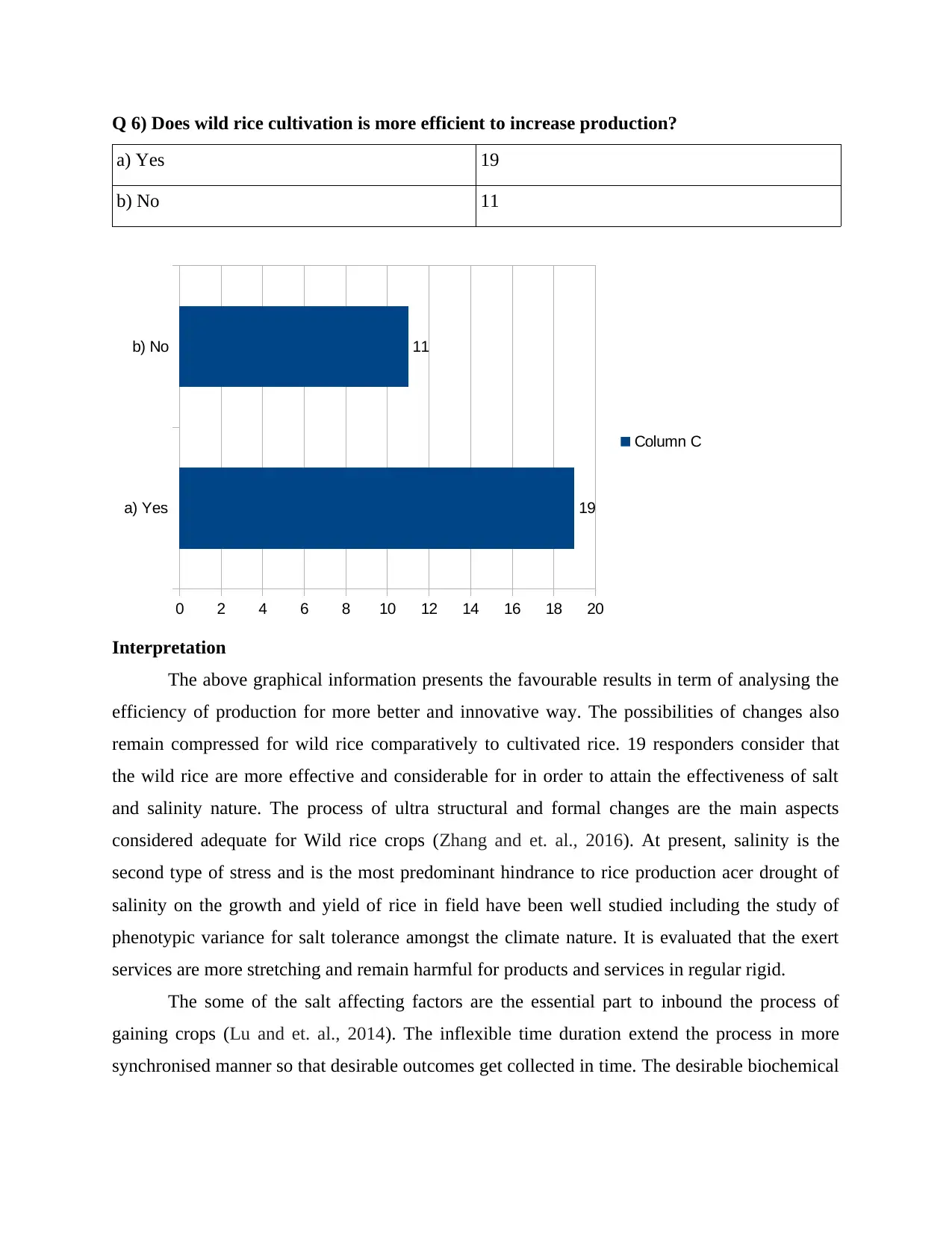
Q 6) Does wild rice cultivation is more efficient to increase production?
a) Yes 19
b) No 11
a) Yes
b) No
0 2 4 6 8 10 12 14 16 18 20
19
11
Column C
Interpretation
The above graphical information presents the favourable results in term of analysing the
efficiency of production for more better and innovative way. The possibilities of changes also
remain compressed for wild rice comparatively to cultivated rice. 19 responders consider that
the wild rice are more effective and considerable for in order to attain the effectiveness of salt
and salinity nature. The process of ultra structural and formal changes are the main aspects
considered adequate for Wild rice crops (Zhang and et. al., 2016). At present, salinity is the
second type of stress and is the most predominant hindrance to rice production acer drought of
salinity on the growth and yield of rice in field have been well studied including the study of
phenotypic variance for salt tolerance amongst the climate nature. It is evaluated that the exert
services are more stretching and remain harmful for products and services in regular rigid.
The some of the salt affecting factors are the essential part to inbound the process of
gaining crops (Lu and et. al., 2014). The inflexible time duration extend the process in more
synchronised manner so that desirable outcomes get collected in time. The desirable biochemical
a) Yes 19
b) No 11
a) Yes
b) No
0 2 4 6 8 10 12 14 16 18 20
19
11
Column C
Interpretation
The above graphical information presents the favourable results in term of analysing the
efficiency of production for more better and innovative way. The possibilities of changes also
remain compressed for wild rice comparatively to cultivated rice. 19 responders consider that
the wild rice are more effective and considerable for in order to attain the effectiveness of salt
and salinity nature. The process of ultra structural and formal changes are the main aspects
considered adequate for Wild rice crops (Zhang and et. al., 2016). At present, salinity is the
second type of stress and is the most predominant hindrance to rice production acer drought of
salinity on the growth and yield of rice in field have been well studied including the study of
phenotypic variance for salt tolerance amongst the climate nature. It is evaluated that the exert
services are more stretching and remain harmful for products and services in regular rigid.
The some of the salt affecting factors are the essential part to inbound the process of
gaining crops (Lu and et. al., 2014). The inflexible time duration extend the process in more
synchronised manner so that desirable outcomes get collected in time. The desirable biochemical
⊘ This is a preview!⊘
Do you want full access?
Subscribe today to unlock all pages.

Trusted by 1+ million students worldwide
1 out of 18
Related Documents
Your All-in-One AI-Powered Toolkit for Academic Success.
+13062052269
info@desklib.com
Available 24*7 on WhatsApp / Email
![[object Object]](/_next/static/media/star-bottom.7253800d.svg)
Unlock your academic potential
Copyright © 2020–2025 A2Z Services. All Rights Reserved. Developed and managed by ZUCOL.





